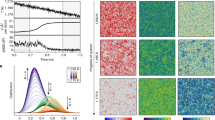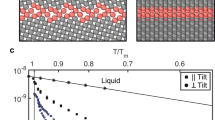Abstract
The mechanism that underlies the recrystallization of amorphous silicon tas not been established. It is generally argued, however, that the rearrangement of the network occurs through the breaking of bonds or the introduction of vacancies and that this step is responsible for the observed activation energy (∼2.5 eV). It is suggested here that the rearrangement of the network is accomplished through the migration of intrinsic overcoordination defects (“floating bonds”) and that this process has a small activation energy (∼0.4 eV). The observed large activation energy is actually due to a reaction that inhibits recrystallization. This reaction may be the elimination of preexisting dangling bonds.
Similar content being viewed by others
References
Values of this quantity for undoped a-Si vary from 2.3 to 2.9 eV. See, e.g., L. Csepregi, E. F. Kennedy, T. J. Callagher, J. W. Mayer, and T. W. Sigmon, J. Appl. Phys. 48, 4234 (1977); A. Lietoila, A. Wakita, T. W. Sigmon, and J. F. Gibbons, J. Appl. Phys. 53, 4399 (1982); G. L. Olson, J. A. Roth, L. D. Hess, and J. Narayan, in Layered Structures and Interface Kinetics, edited by S. Furukawa, (KTK Scientific Publishers, Tokyo, 1985), p. 73.
R. Car, P. J. Kelly, A. Oshiyama, and S. T. Pantelides, Phys. Rev. Lett. 52, 1814 (1984), and 54, 360 (1985); Y. Bar-Yam and J. D. Joannopoulos, J. Electron. Mater. 14, 261 (1985).
S. Dannefaer, P. Mascher, and D. Kerr, Phys. Rev. Lett. 56, 2195 (1986).
F. Spaepen and D. Turnbull, in Laser-Solid Interactions and Laser Processing, edited by S. D. Ferris, H. J. Leamy, and J. M. Poate, (American Institute of Physics, New York, 1978), p. 73.
P. J. Germain, M. A. Paesler, D. E. Sayers, and K. Zellama, MRS Symp. Proc. vol. 13, p. 135 (1983).
L. E. Mosley and M. A. Paesler, Appl. Phys. Lett. 45, 86 (1984)
R. Drosd and J. Washburn, I. Appl. Phys. 53, 397 (1982).
J. Narayan, J. Appl. Phys. 53, 8607 (1982).
S. T. Pantelides, Phys. Rev. Lett. 57, 2979 (1986); ibid. 58, 1344 (1987); Phys. Rev. B 36, 3479 (1987).
Ρ. Α. Thomas, M. H. Brodsky, D. Kaplan, and D. Lepine, Phys. Rev. B 18, 3059 (1978).
J. Linnros, B. Svensson, and G. Holmen, Phys. Rev. Β 30, 3629 (1984).
See, e.g., R. A. Street, Phys. Rev. Lett. 49, 1187 (1982).
J. H. Stathis and S. T. Pantelides, to be published.
Author information
Authors and Affiliations
Rights and permissions
About this article
Cite this article
Pantelides, S.T. Defect Dynamics in Amorphous Silicon – the Recrystallization Process. MRS Online Proceedings Library 100, 387 (1987). https://doi.org/10.1557/PROC-100-387
Published:
DOI: https://doi.org/10.1557/PROC-100-387




